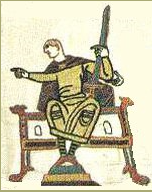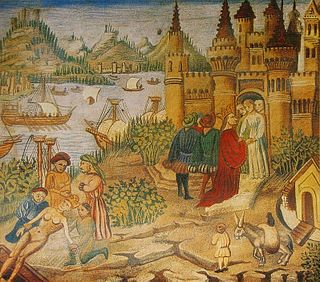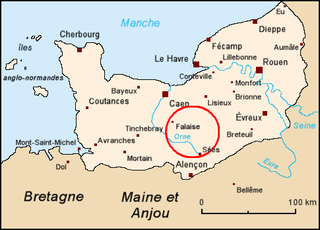Related Research Articles

Herleva was an 11th-century Norman woman known for having been mother of William the Conqueror, born to an extramarital relationship with Robert I, Duke of Normandy, and also of William's prominent half-brothers Odo of Bayeux and Robert, Count of Mortain, born to Herleva's marriage to Herluin de Conteville.

Robert I of Normandy, also known as Robert the Magnificent and by other names, was a Norman noble of the House of Normandy who ruled as duke of Normandy from 1027 until his death in 1035. He was the son of Duke Richard II; the brother of Duke Richard III, against whom he unsuccessfully revolted; and the father of Duke William who became the first Norman king of England in 1066. During his reign, Robert quarrelled with the church—including his uncle Robert, archbishop of Rouen—and meddled in the disorder in Flanders. He finally reconciled with his uncle and the church, restoring some property and undertaking a pilgrimage to Jerusalem, during which he died.

Robert, Count of Mortain, first Earl of Cornwall of 2nd creation was a Norman nobleman and the half-brother of King William the Conqueror. He was one of the very few proven companions of William the Conqueror at the Battle of Hastings and as recorded in the Domesday Book of 1086 was one of the greatest landholders in his half-brother's new Kingdom of England.

Robert I, known as Robert the Frisian, was count of Flanders from 1071 until his death in 1093. He was a son of Baldwin V, Count of Flanders, and the younger brother of Baldwin VI, Count of Flanders. He usurped the countship after defeating his nephew Arnulf III and his allies, which included King Philip I of France, Count Eustace of Boulogne and the counts of Saint-Pol and Ardres at the Battle of Cassel. He subsequently made peace with Philip, who became his stepson-in-law, but remained hostile to his sister Matilda and her husband William the Conqueror, who was king of England and duke of Normandy.
Robert de Bellême, seigneur de Bellême, seigneur de Montgomery, viscount of the Hiémois, 3rd Earl of Shrewsbury and Count of Ponthieu, was an Anglo-Norman nobleman, and one of the most prominent figures in the competition for the succession to England and Normandy between the sons of William the Conqueror. He was a member of the powerful House of Bellême.
Alan III of Rennes was Count of Rennes and duke of Brittany, by right of succession from 1008 to his death.
David Bates is a historian of Britain and France during the period from the tenth to the thirteenth centuries. He has written many books and articles during his career, including Normandy before 1066 (1982), Regesta Regum Anglo-Normannorum: The Acta of William I, 1066–1087 (1998), The Normans and Empire (2013), William the Conqueror (2016) in the Yale English Monarchs series and La Tapisserie de Bayeux (2019).
William de Warenne, 1st Earl of Surrey, Lord of Lewes, Seigneur de Varennes, was a Norman nobleman created Earl of Surrey under William II Rufus. He is among the few known from documents to have fought under William the Conqueror at the Battle of Hastings in 1066. At the time of the Domesday Book in 1086, he held extensive lands in 13 counties, including the Rape of Lewes, a tract now divided between the ceremonial counties of East Sussex and West Sussex.

Richard I, also known as Richard the Fearless, was the count of Rouen from 942 to 996. Dudo of Saint-Quentin, whom Richard commissioned to write the "De moribus et actis primorum Normanniae ducum", called him a dux. However, this use of the word may have been in the context of Richard's renowned leadership in war, and not as a reference to a title of nobility. Richard either introduced feudalism into Normandy or he greatly expanded it. By the end of his reign, the most important Norman landholders held their lands in feudal tenure.

Gesta Normannorum Ducum is a chronicle originally created by the monk William of Jumièges just before 1060. In 1070 William I had William of Jumièges extend the work to detail his rights to the throne of England. In later times, Orderic Vitalis and Robert of Torigni, extended the volumes to include history up until Henry I.

Guy I of Ponthieu was born sometime in the mid- to late 1020s and died 13 October 1100. He succeeded his brother Enguerrand as Count of Ponthieu.

Gunnor or Gunnora was Duchess of Normandy by marriage to Richard I of Normandy, having previously been his long-time mistress. She functioned as regent of Normandy during the absence of her spouse, as well as the adviser to him and later to his successor, their son Richard II.

William the Conqueror had men of diverse standing and origins under his command at the Battle of Hastings in 1066. With these and other men he went on in the five succeeding years to conduct the Harrying of the North and complete the Norman conquest of England.

The Battle of Mortemer was a defeat for Henry I of France when he led an army against his vassal, William the Bastard, Duke of Normandy in 1054. William was eventually to become known as William the Conqueror after his successful invasion and conquest of England.
Walter Giffard, Lord of Longueville in Normandy, 1st Earl of Buckingham was an Anglo-Norman magnate.

Sibylla of Conversano was a wealthy Norman heiress, Duchess of Normandy by marriage to Robert Curthose. She was regent of Normandy during the absence of her spouse.
Mora was the name of William the Conqueror's flagship, the largest and fastest ship in his invasion fleet of 700 or more ships used during the Norman conquest of England in 1066.

Roger de Montgomery, was seigneur of Montgomery, vicomte of the Hiémois, and a member of the House of Montgomery.
Rohese Giffard was a Norman noblewoman in the late 11th and early 12th century. The daughter of a Norman noble, she was the wife of another Norman noble, Richard fitzGilbert, who was one of the ten wealthiest landholders there after the Norman Conquest. Rohese is mentioned in Domesday Book as a landholder in her own right, something uncommon for women. She and Richard had a number of children, and she lived on past his death around 1086, until at least 1113 when she is recorded giving lands to a monastery. Her descendants eventually inherited her father's lands, although this did not occur until the reign of King Richard I of England.

The de Warenne family were a noble family in England that included the first Earls of Surrey, created by William the Conqueror in 1088 for William de Warenne, 1st Earl of Surrey, who was among his companions at the Battle of Hastings. The family originated in Normandy and, as Earls, held land there and throughout England. When the senior male-line ended in the mid-12th century, the descendants of their heiress adopted the Warenne surname and continue as Earls of Surrey for another two centuries. Several junior lines also held land or prominent offices in England and Normandy.
References
- 1 2 Edward A. Freeman, The History of the Norman Conquest of England , Vol. III (Oxford: At the Clarendon Press, 1869),p. 465
- ↑ Records of Buckinghamshire, Vol 8, Ed. John Parker (Aylesbury: G.T. de Fraine, "Bucks Herald" Office, 1903), pp. 289-293.
- ↑ G.H. White, "The Sisters and Nieces of Gunnor, Duchess of Normandy", The Genealogist, New Series, vol. 37 (1920-21), pp. 57–65 & 128–132; Elisabeth van Houts, "Robert of Torigni as Genealogist", Studies in Medieval History presented to R. Allen Brown, Boydell Press, 1989, pp. 215–233
- ↑ George Edward Cokayne, The Complete Peerage of England Scotland Ireland Great Britain and the United Kingdom, Extant Extinct or Dormant, Vol. II, Ed. Vicary Gibbs (London: The St. Catherine Press, Ltd., 1912), p. 386 note (a)
- ↑ David Crouch,The Normans (New York: Hambledon Continuum, 2002), p.64
- ↑ David C. Douglas, William the Conqueror (Berlekey and Los Angeles: The University of California Press, 1964), p. 68
- 1 2 3 François Neveux, A Brief History of the Normans, Trans. Howard Curtis (London: Constable & Robinson, Ltd., 2008), p. 127
- ↑ David C. Douglas, William the Conqueror (Berlekey and Los Angeles: The University of California Press, 1964), p. 388
- 1 2 3 T. A. Archer, "Giffard of Barbastre", The English Historical Review, Vol. 18, No. 70 (Apr., 1903), p. 304
- ↑ Archer, 'Giffard of Barbastre', EHR, 18, 70 (1903), pp. 304-05; Lomax, 'The First English Pilgrims to Santiago de Compostela', Studies in Medieval History: Presented to R.H.C.Davis Ed. Henry Mayr-Harting, Hambldeon (1985), 165-176.
- 1 2 D.W. Lomax, "The First English Pilgrims to Santiago de Compostela", Studies in Medieval History: Presented to R.H.C.Davis, Ed. Henry Mayr-Harting and R.I. Moore (London: The Hambledon Press, 1985), p. 166
- 1 2 Elisabeth M.C. van Houts, "The Ship List of William the Conqueror", Anglo-Norman Studies X; Proceedings of the Battle Conference 1987, Ed. R. Allen Brown (Woodbridge UK: The Boydell Press, 1988), p. 161
- ↑ Anglo-Norman Studies X, Proceedings of the Battle Conference 1987, ed. R. Allen Brown, The Boydell Press, Woodbridge, UK 1988, Appendix 4. "Ships list of William the Conqueror"
- ↑ Sanders, I.J. English Baronies: A Study of their Origin and Descent 1086-1327, Oxford, 1960, pp.62-4
- 1 2 George Edward Cokayne, The Complete Peerage of England Scotland Ireland Great Britain and the United Kingdom, Extant Extinct or Dormant, Vol. II, Ed. Vicary Gibbs (London: The St. Catherine Press, Ltd., 1912), p. 387
- 1 2 3 4 Detlev Schwennicke, Europäische Stammtafeln: Stammtafeln zur Geschichte der Europäischen Staaten , Neue Folge, Band III Teilband 4 (Marburg, Germany: Verlag von J. A. Stargardt, 1989, Tafel 695
- ↑ K.S.B. Keats-Rohan, Domesday People, A Prosopography of Persons Occurring in English Documents 1066-1166, Volume I, Domesday Book (The Boydell Press, Woodbridge, 1999), p. 456
- ↑ C. Warren Hollister, "The Strange Death of William Rufus", Speculum, Vol. 48, No. 4 (Oct., 1973), pp. 645-46